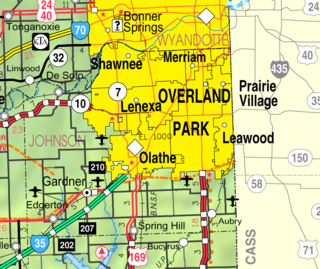
Kansas City, Missouri is the largest city in the U.S. state of Missouri by population and area. Most of the city lies within Jackson County, and other portions spill into Clay, Platte, and Cass counties. It is the central city of the Kansas City metropolitan area, which straddles the Missouri–Kansas state line and has a population of 2,392,035. As of the 2020 census, the city had a population of 508,090, making it the 37th most-populous city in the United States, as well as the sixth-most populous city in the Midwest. Kansas City was founded in the 1830s as a port on the Missouri River at its confluence with the Kansas River from the west. On June 1, 1850, the town of Kansas was incorporated; shortly after came the establishment of the Kansas Territory. Confusion between the two ensued, and the name Kansas City was assigned to distinguish them soon after.

Leawood is a city in Johnson County, Kansas, United States, and is part of the Kansas City metropolitan area. As of the 2020 census, the population of the city was 33,902.

The Kansas City Star is a newspaper based in Kansas City, Missouri. Published since 1880, the paper is the recipient of eight Pulitzer Prizes.
James L. Miller Sr. (1897–1989) was an immigrant to the United States who immigrated at the age of 3 in 1901. He served in World War I and later worked as a reporter for The Kansas City Star and Kansas City Times, in Kansas City, Missouri.

Jesse Clyde "J. C." Nichols was an American developer of commercial and residential real estate in Kansas City, Missouri. Born in Olathe, Kansas, and a student at the University of Kansas and Harvard University, his most notable developments are the Country Club District and Country Club Plaza in Kansas City, which influenced suburban developments in other parts of the United States. He served leadership roles in local and national real estate organizations. Through these organizations, his ideas about real estate and planning helped to shape methods for racist and anti-Semitic restrictive covenants and zoning. His legacy has come under increasing scrutiny for these covenants, which prohibited Blacks, Jews, and other minorities from living in these neighborhoods.

The Nelson-Atkins Museum of Art is an art museum in Kansas City, Missouri, known for its encyclopedic collection of art from nearly every continent and culture, and especially for its extensive collection of Asian art.

The history of the Kansas City metropolitan area relates to the area around the confluence of the Kansas and Missouri Rivers and the modern-day city of Kansas City, Missouri.
The Kansas City Times was a morning newspaper in Kansas City, Missouri, published from 1867 to 1990. The morning Kansas City Times, under ownership of the afternoon Kansas City Star, won two Pulitzer Prizes and was bigger than its parent when it was renamed Kansas City Star.
The list of neighborhoods of Kansas City, Missouri has nearly 240 neighborhoods. The list includes only Kansas City, Missouri and not the entire Kansas City metropolitan area, such as Kansas City, Kansas.
The Country Club District is a group of neighborhoods comprising a historic upscale residential district in Kansas City, developed by noted real estate developer J.C. Nichols.

Joseph Jackson Davenport was a lawyer, realtor and Mayor of Kansas City, Missouri in 1889. He moved to Kansas City from his native Saint Louis in about 1873, joining "the pork-packing business with J. E. McKenzie," and after his term as mayor entering real estate. Following his term a new city charter was implemented and terms were extended to two years.

Walter Simpson Dickey was a Canadian-born newspaper publisher, politician, and industrialist in Kansas City, Missouri.

Southmoreland is a neighborhood of Kansas City, Missouri. It hosts the Nelson-Atkins Museum of Art, the Kemper Museum of Contemporary Art, and the Kansas City Art Institute. Southmoreland is located between 39th Street on the north, Rockhill, and Gillham Road on the east, Emanuel Cleaver II Boulevard on the south and Main Street on the west. Since 2019, following finalized plans for a streetcar extension from Union Station to University of Missouri–Kansas City, there has been new real estate development along Main Street.
Monkey Mountain refers to both a hill in Jackson County, Missouri and the nature preserve surrounding it. Its elevation is 948 ft (289 m). The mountain is located at 39°00′21″N94°10′55″W.
Laurence Chalfant Stevens Sickman (1907–1988) was an American academic, art historian, sinologist and Director of the Nelson-Atkins Museum of Art in Kansas City.

Troost Avenue is one of the major streets in Kansas City, Missouri and the Kansas City metropolitan area. Its northern terminus is at 4th Street and its southern terminus Bannister Road, totaling 10.7 miles (17.2 km). It is named after Kansas City's first resident physician, Benoist Troost.

Emory J. Sweeney, better known as E. J. Sweeney, was the founder and president of the Sweeney Automobile School in Kansas City, Missouri. E. J. Sweeney also developed the Santa Fe Hills neighborhood in South Kansas City.

Streetcars in Kansas City were the primary public transit mode during the late 19th and early 20th centuries, like most North American cities. Kansas City, Missouri once had one of the most extensive streetcar systems in North America, but the last of its 25 streetcar routes was shut down in 1957.
Sni-A-Bar Township is an inactive township in Jackson County, in the U.S. state of Missouri. It was annexed into the city of Kansas City, Missouri and is within the Kansas City metropolitan area.
Sidney John Hare was an American landscape architect. He worked with his son S. Herbert Hare with the landscaping company Hare & Hare.












